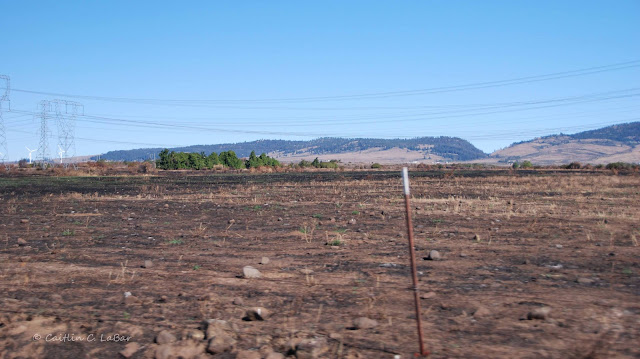Escape
During the first few days of the fire, I read many news articles about the destruction and evacuations, nervously waiting to hear whether some friends had evacuated or if the fire was threatening their homes (everyone I know is safe, although some were quite close to the fire). In one article (about half-way down the page), I read that "swarms of grasshoppers" were seen crossing Highway 97 in an attempt to escape the fire. I am not familiar with grasshoppers enough to know why they were crawling and not flying, although they may have been nymphs; immature grasshoppers that do not have functioning wings and therefore must crawl instead of fly. Adult butterflies could potentially fly out of the way of a fire, particularly strong fliers such as swallowtails and nymphalids (brush-footed butterfly family). However, this fire was moving at least 25 mph in some places, and wind gusts were reaching above 30 mph. In addition to the suffocating smoke, the fire was moving so fast that I doubt many butterflies and other insects would have been able to leave the area in time, not to mention all the eggs, larvae, and pupae that are incapable of outrunning a fire.
While they may not outrun it, there are ways they can escape harm if the fire is burning naturally at a low intensity. Larvae of some species seek shelter during the day by hiding at the base of their host plants or shrubs, either under the duff or in loose soil and rocks. Butterfly species whose larvae feed on trees or tall bushes may escape low-intensity fires if they are high up in the plant. As you'll see in my photos, some areas were completely scorched, while other areas were only lightly burned, leaving many bushes and trees with green tops.
Repopulation
Fire is a natural occurrence in nature that helps balance and restore ecosystems, restarting a process of ecological succession. Ecological succession is the process of change in a community of plants and animals. Over time, duff (dead plant material) builds up and can choke out plants and prevent new plants from sprouting. Fire clears areas of duff, brush and trees, and returns nutrients to the soil. This opens up new habitat for wildflowers and grasses, and eventually more bushes and trees, along with the animals that are associated with each type of plant. If an area is prevented from burning for many years it can disrupt the natural cycle and allow a buildup of dead plant material, so that when it finally burns, it burns much hotter than normal. An unnaturally hot fire will kill not only many seeds, but also any insects or other animals hiding just underground or in other areas that would be protected in "cool" fires.Although butterflies are killed by fire, it is their friend in the sense that it renews and protects their habitat by allowing many of their larval host-plants and nectar flowers to flourish. It is well-documented that only a year or two after a fire, butterfly numbers are often higher than in years before the fire, due to the new flush of plants. Butterflies and other insects re-colonize burned areas from surrounding un-burned habitat, which is why it is critical that fires (wild and prescribed) are not over an area that would destroy an entire population. Un-burned islands within the fire perimeter also contribute seeds and animals to the recolonization of the burned area.
The area northwest of Ellensburg may be charred and black right now, but some areas area already turning green with new blades of grass, and next spring the hillsides will be covered with grass and flowers bolstered by the new source of nutrients, attracting new butterflies and other insects, which will likely abound in another couple years.
 |
| Grass is already coming up in this blackened area along Reecer Creek Road |

Hi. I just discovered your blog. I manage the butterfly house at Pacific Science Center, and am always looking for content. This is a great blog, I will alert my staff to it. It answers many questions we get, as well as dealing with topical situations as they come up (like the fire).
ReplyDeleteLooking forward to reading more from you.
Regards
Sarah M
Thanks for your comment, I actually just visited the PSC last weekend to see the King Tut exhibit, and spent some time in the butterfly house, my third visit since it was built. I was excited to see a few species I hadn't seen before, although I couldn't figure out what two of the swallowtails were and I haven't had time to study my photos of them. One was large and looked like a two-tailed tiger, but was a little different, and the other was mostly very pale yellow.
Delete